
You’ve probably seen, or at the very least heard of, Alfred Hitchcock’s classic film Rear Window. Hitting movie screens in 1954, this thriller starred James Stewart as a photographer with a broken leg who believes he may have witnessed a murder in another apartment.
Who could have anticipated that, 68 years later, someone would make a board game based on that movie?
What Is Rear Window?
Rear Window is a semi-cooperative deduction game for 3-5 players, ages 13 and up, and takes about 40 minutes to play.
Rear Window was designed by Prospero Hall and published by Funko Games. It retails for $34.99 and is available to purchase on Amazon. It would normally be available on the Funko Games Webstore as well, but as of this writing, it is currently sold out there.
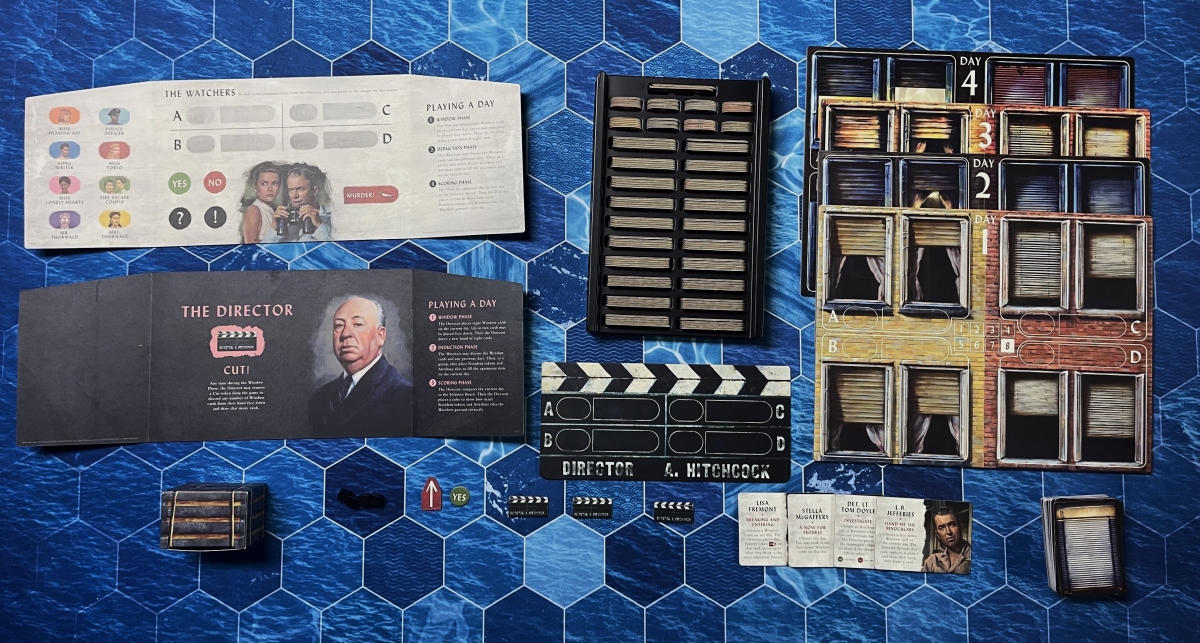
Rear Window Components
I don’t normally cover rulebooks when I discuss board game components, but I was just so in love with this one I had to mention it. In keeping with the period of the movie, the cover of the rulebook is designed to look like an old Life magazine cover. The “cover photo” is even by Jimmy Stewart’s character.

Similarly, the artwork on the Day Boards is evocative of the film Rear Window itself. It’s as if we, as the players, are looking into the same apartment windows as L. B. Jefferies.

The Director will play Window cards onto the Day Boards, which will give players clues to the identities of the apartment dwellers. The artwork, again, captures the feeling of the period perfectly. My only complaint about them is that they are standard playing card size. As such, it can be a little hard to see the finer details in the illustrations. It would have been nice if Funko had opted for an oversized Tarot card.
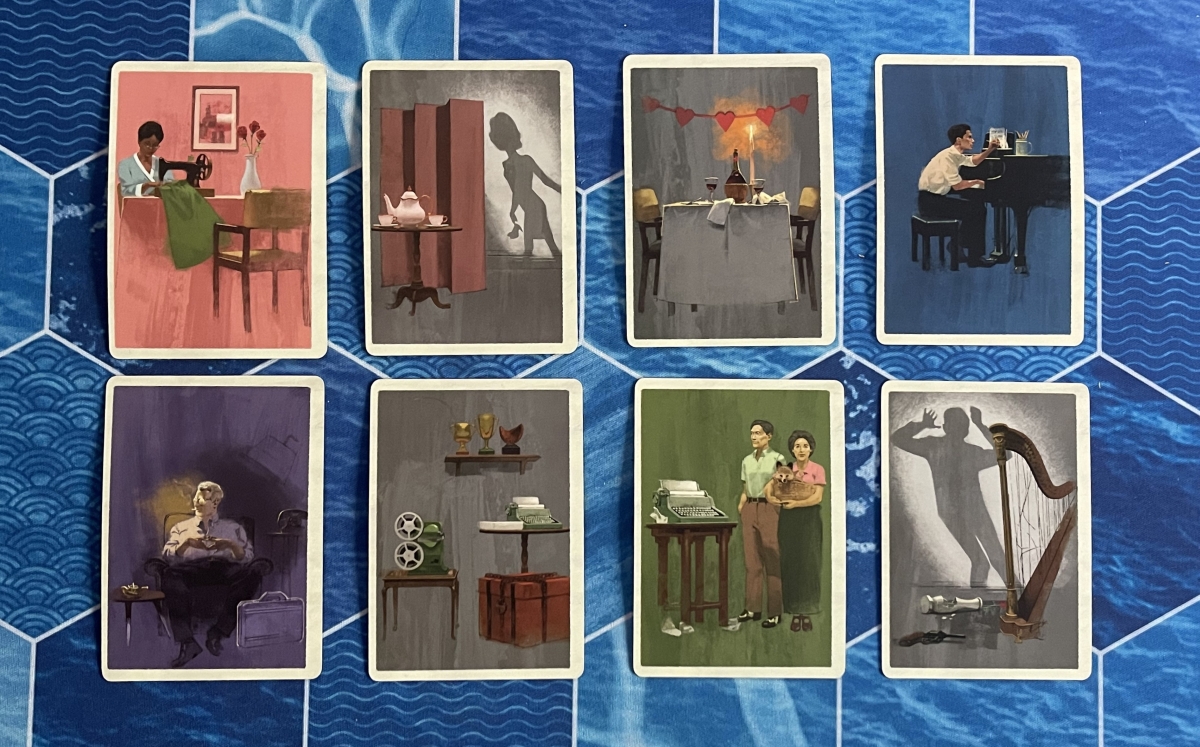
Both the Director and the other players, known as Watchers, have their own cardboard screens, to keep information private from the others.

Each screen also has an evocatively illustrated side facing the other players, showing off more of the apartment exteriors as viewed in the film.

To aid in setting up and putting away the game, there’s a great little insert that holds all of the tokens used by the Watchers. The tokens all punch out cleanly and easily from their boards.
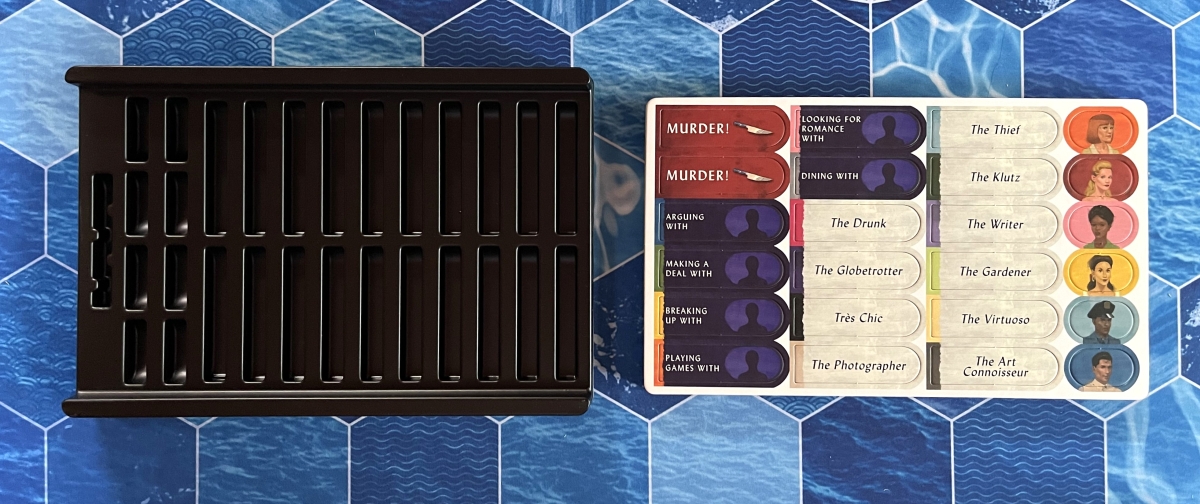
The token holder comes with a clear plastic cover, to ensure that you don’t end up with a mess of tokens loose inside your game box.
In keeping with other Prospero Hall games, the production values for Rear Window are quite nice, especially for the very affordable price point.
How to Play Rear Window
You can download a copy of the rulebook here.
The Goal
The goal of Rear Window is for the Director to guide the Watchers to guess all 8 spots correctly on the Day Board. Though that goal will change for the Director if there was a murder that takes place. Skip to “Game End” below to see how!

Setup
Decide who will play as the Director, with everyone else playing as Watchers. Set up the Watcher and Director screens at opposite ends of the table. Place the Day boards between them, with the “Day 1” board face up, and the other 3 boards face down.
The Director places the Solution Board behind his screen, oriented to match the orientation of the Day boards.
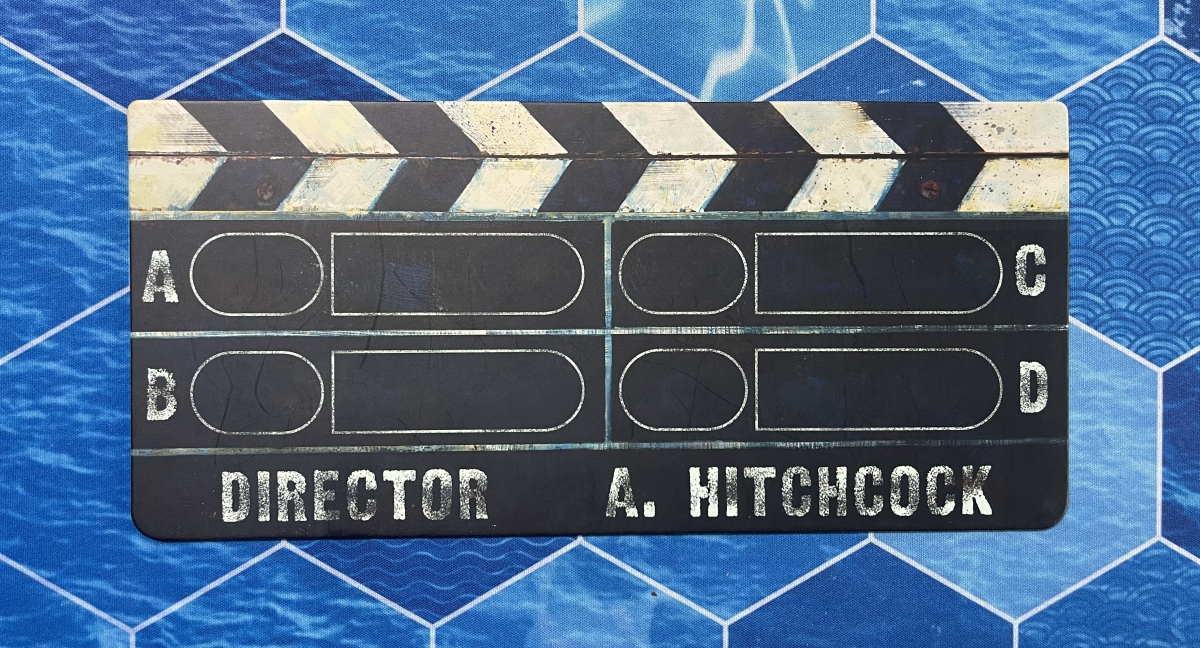
Place the 4 Watcher placards face up next to the Day Boards, along with the Pointer and Investigate tokens.
The Watchers take both Murder tiles and four of each of the Resident tokens. The Director takes the remaining Resident tokens.
The Director shuffles the Window cards, creating a face-down deck. They will also take the 3 Cut tokens, the 4 wooden cubes, and the Trunk.
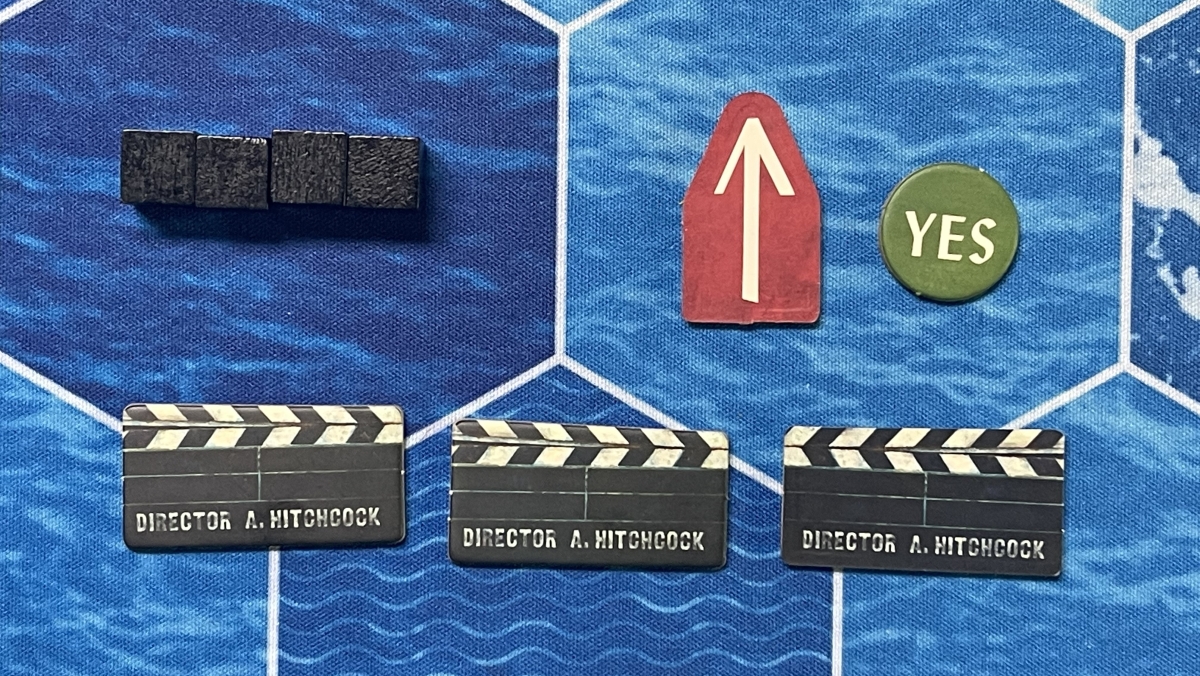
Watcher’s Setup
As a group, the Watchers select any 12 Attributes. They take all 5 tiles of each attribute and place them face-up next to the Day boards. They then take 1 of each of the Attribute tiles and 1 of the Murder tiles, shuffle them together, and create a face-down stack that they pass to the Director.
Director’s Setup
The Director draws 4 random tiles from the face-down stack and places one face-up on each of the four Attribute spots on the Solution Board. Place the rest of the tiles in the Trunk box. Then choose any 4 Residents and place their tiles on the open Resident spaces on the Solution Board. If any Purple Attribute tiles are used, also place an additional Resident tile on the open spot on that Attribute tile. Place any remaining Residents into the Trunk box.
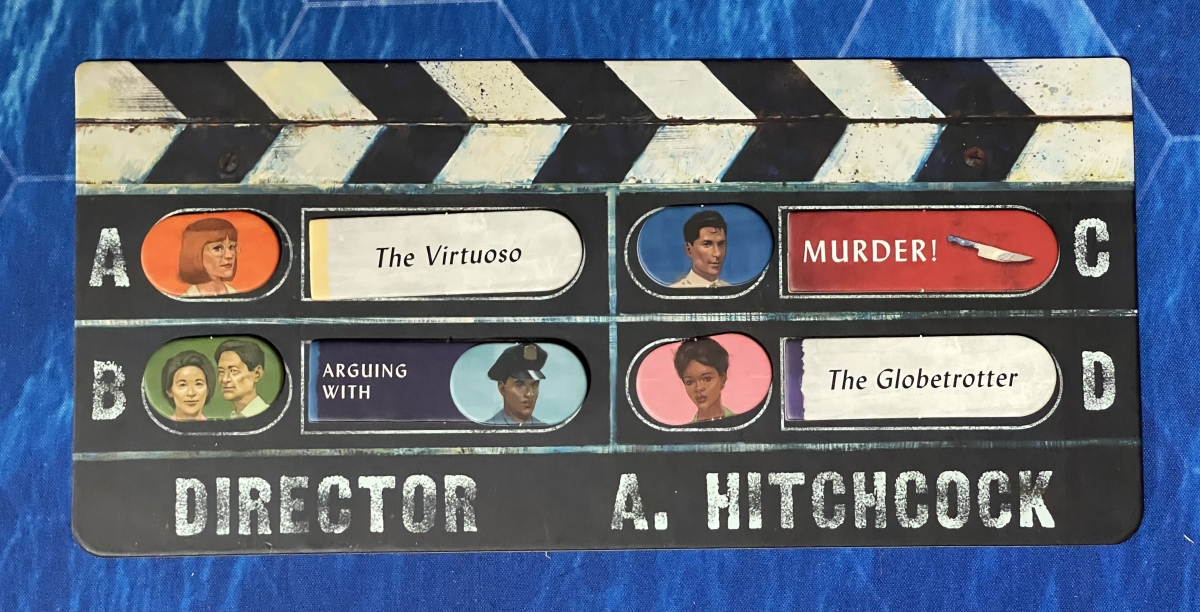
Finally, the Director draws 8 Window cards from their deck.
Gameplay
A game of Rear Window is divided up into 3 phases, which are repeated over the course of 4 rounds or “days.”
Window Phase
The Director plays eight Window cards on the current Day Board, in an attempt to communicate each apartment’s Resident and Attribute to the Watchers (or hide a murder). The Director may not speak or otherwise give hints, verbal or non-verbal.
For each day, the Director may play up to 2 of the Window cards face-down.
The Director also has 3 Cut tokens. By removing a Cut token, the Director may discard as many cards from their hand as they want, and draw back up to eight.
After placing their Window cards, the Director draws a new hand of eight cards.

Deduction Phase
This is the phase where the Watchers examine the cards that the Director has laid out and try to deduce both which Residents live in which apartments and their Attributes. The Watchers place Attribute tiles and Resident tokens in the appropriate spaces on the Day board according to their guesses.
They may never use duplicate tokens or tiles on the same day, nor can they place the Murder tile on any day but the 4th.
If any Purple Attribute tiles are in play, the Watchers must also place a Resident token on that tile at the same time that they place the tile on the Day board.
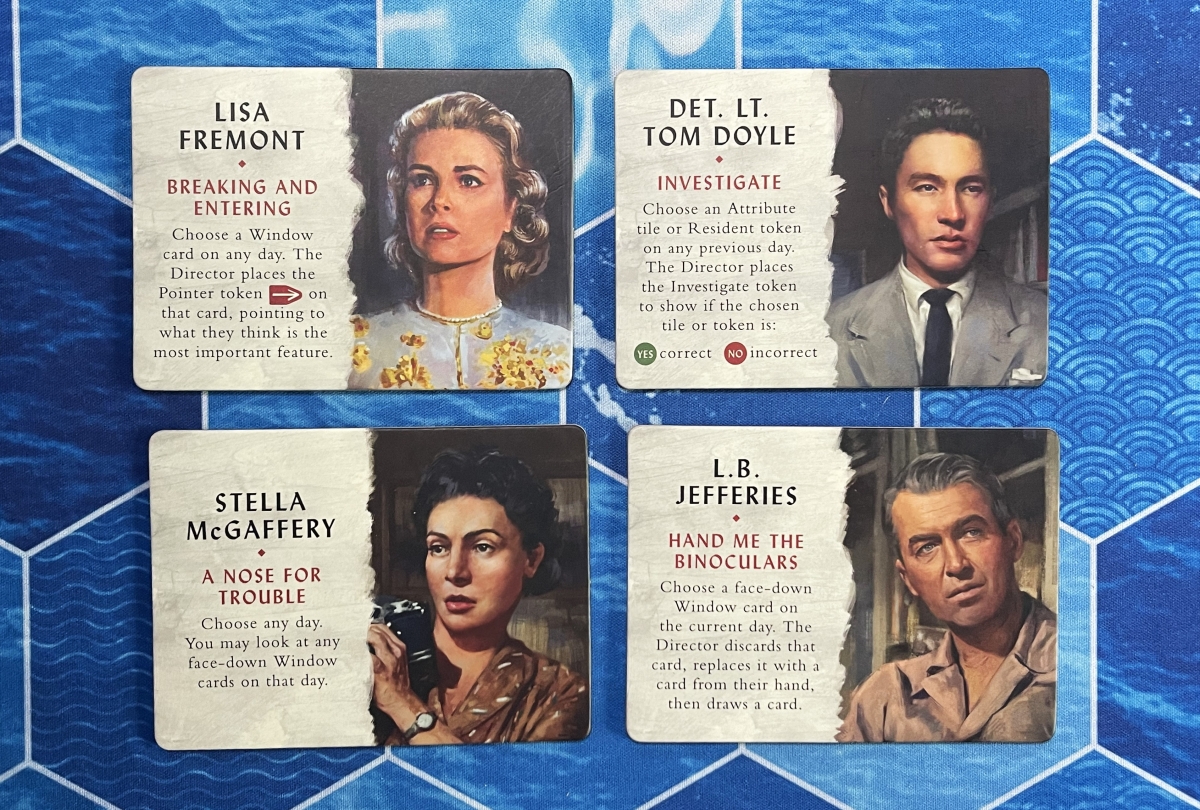
The one other tool at the Watchers’ disposal is the Watcher Placards. These are special powers that can be used at any time during any Deduction Phase, but each may only be used once. After using a Placard, you would flip it over to indicate it is no longer available for the rest of the game.
Scoring Phase
After the Watchers have indicated that they have finished guessing for the day, then the Director compares their guesses with what is on the Director’s Solution Board. The Director then places a black cube on the number matching the correct number of guesses for the current day. If a purple Attribute tile is in play, both the Attribute and the accompanying Resident token must be correct for that tile to count as correct.
Game End
How the game ends will vary, depending on whether the Director pulled and placed the Murder tile during setup! However, the Watchers won’t know whether there was for sure a murder until the end of the game.
If There Was Not a Murder
If there was no murder, then the game is purely cooperative and is won or lost by everyone. To win the game, the Watchers must guess all eight spots correctly by the end of the 4th day. If they guess all eight spots on an earlier day, the game ends early with a win for everyone. However, if they cannot guess all eight spots by the end of the 4th day, everyone loses.
If There Was a Murder
The Director wins if, on Day 4, the Watchers guess six or seven spots correctly, but do not guess the Murder tile correctly.
The Watchers win if, on Day 4, the Watchers guess seven or eight spots correctly, including the Murder tile.
Rear Window is GeekDad Approved!
Why You Should Play Rear Window
It seems these days that you either have big, complex games that take several hours to play or ultra-casual, simple games that play in a half-hour or less. It’s refreshing that with Rear Window, you can set up the game, teach it to new players, and get in an entire game in about 45 minutes. You’ll be using a lot of brain power while you’re playing, no matter whether you’re the Director or one of the Watchers. But mechanically, Rear Window is simple and straightforward—a game that’s easy to get to the table with both casual and serious gamers.
I’d be ignoring the elephant in the room if I didn’t mention Mysterium, a game that is definitely a kissing cousin to Rear Window. Both games have a silent clue-giver that tries to guide the other players to figure out what’s going on in regards to a murder (or specifically in the case of Rear Window, a potential murder). Both games use illustrated cards to give out clues. Both Mysterium and Rear Window integrate their themes with the gameplay excellently, each looking fantastic on the table in its own way. But Rear Window is a definite evolution of the type of deduction game we see in the earlier Mysterium.
For one, the setup in Mysterium is a fairly involved process, and the rules are somewhat complex. Rear Window manages to capture the same feel of gameplay as that earlier game, but with a much lower bar for entry for the casual gamer. And Rear Window adds an additional wrinkle to the gameplay by having the Murder tile shuffled in with the Attribute tiles. The Watchers will not only have to identify the apartment Residents, but they’ll have to figure out whether or not the Director is playing with them or against them.
This Schrödinger’s Cat of a murder creates an additional layer of deduction for the Watchers. It can also make things more challenging for the Director, as they will still need the Watchers to guess most of the clues for the Director to win. The optional Purple Attribute tiles create an additional layer of complexity and difficulty and are easy to incorporate into the game if you choose. Thankfully, the Watchers have those four Watcher Placards, which can help out quite a bit with figuring out clues when they get stuck. The trick for them is knowing when it’s a good time to use them.
My only real negative for the game is that the smaller Window cards can be a little difficult to see at a distance and would require Watchers to either pick them up or move closer to see the finer details. While it would be nice to have some larger cards as you find in Mysterium, super-sizing the Window cards would likely result in turning Rear Window into a table hog, whereas it currently fills a table but doesn’t overtake it. Perhaps if the game is successful, Funko might consider a second, larger version, similar to Codenames XXL. And while this isn’t a negative, my group never really used the Watcher screen for its intended purpose, which is to silently point towards guesses without cluing the Director into your thought processes. It would definitely be useful if you have a Director as devious as Hitchcock. In such a case, the Watchers don’t want to let the Director know their line of reasoning, so as not to give the Director an advantage should a murder have taken place.
When I first played Rear Window, we finished our first game, and then everyone wanted to jump right into a second. And that second game soon became a third. Each of the games had someone else playing the Director. Out of the 3 games, we had no murder in the first and won at the end of the third round. In the 2nd game, it turned out there was a murder, but we guessed that there wasn’t and the Director won. And in the third game, there wasn’t a murder, but we got confusing signals from the Director and guessed that there was, and so we all lost.
Importantly, we were all actively engaged in each of the games and had a great time, win or lose. As with any deduction game of this nature, a skilled and experienced player playing as the Director will enhance the gameplay for all the players. But the accessibility of Rear Window also allows less experienced players to jump in and try out a role that they might find daunting in other, similar games. Rear Window is a great choice for game night, and with its shorter length can either be played multiple times in a session or be one of several games to hit your table. The classic film Rear Window may have just inspired a classic board game.
For more information, check out the Rear Window page at Funko Games’ website.

Click here to see all our tabletop game reviews.
![]() To subscribe to GeekDad’s tabletop gaming coverage, please copy this link and add it to your RSS reader.
To subscribe to GeekDad’s tabletop gaming coverage, please copy this link and add it to your RSS reader.
Disclosure: GeekDad received a copy of this game for review purposes. As an Amazon affiliate, I may earn a small commission on qualified purchases.
Click through to read all of "You’ll Want to Look Into This ‘Rear Window’" at GeekDad.If you value content from GeekDad, please support us via Patreon or use this link to shop at Amazon. Thanks!


